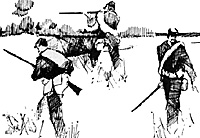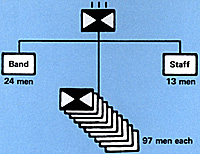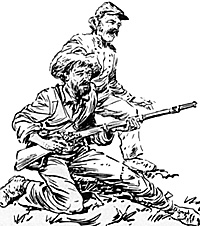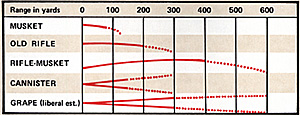 All great wars as heretofore will depend chiefly upon the infantry.
All great wars as heretofore will depend chiefly upon the infantry.
Both numerically and with effects of its action, the infantry formed the backbone of the typical Civil War army. Being the easiest to train and the cheapest to maintain, the infantry was the most common of the arms of battle upon the field.
Since it was the most adaptable to terrain features and the most adaptable to independent action, the infantry was to bear the brunt of battle. Often the infantry was assigned the task of directly assaulting the enemy's position or the duty of defending the battleline from assault.
As could be expected from all of this, the infantry gave and received the bulk of casualties in battle. When commenting upon the green troops at the First Bull Run, General Emory Upton bitterly remarked that with "A year's training these same troops would have spurned losses of 30 to 50%."
In some cases individual brigades lost 80% or 90% of their men engaged. The Iron Brigade at Gettysburg suffered 70% casualties in one single day. Such were the infantry's battle losses.
In order to withstand such heavy losses, the infantry had to be thoroughly organized. Recruits were first assigned to one of the ten companies that made up a regiment. Once the recruits had mastered the company drill, the companies of the regiment were united in order to practice regimental evolutions. Unity of movement was paramount to a regiment because the evolutions would often have to be performed in wooded country and under fire. To the colonels of the regiment, this meant drilling until the evolutions were second nature. As one pavate remarked, "The first thing in the morning is drill, then drill, then drill, then drill again."
 At right, this was the ideal organization for a standard infantry regiment in the Civil War. The commanding colonel's staff was rarely as large as thirteen men and the band was infrequently seen in a campaign. Of the ten companies in the regiment, about 40 to 60 infantrymen per company was the norm. Allotted some 1,000 men, the regiment mustered about 400 effectives in the Union Army and around 600 in the Confederate forces.
At right, this was the ideal organization for a standard infantry regiment in the Civil War. The commanding colonel's staff was rarely as large as thirteen men and the band was infrequently seen in a campaign. Of the ten companies in the regiment, about 40 to 60 infantrymen per company was the norm. Allotted some 1,000 men, the regiment mustered about 400 effectives in the Union Army and around 600 in the Confederate forces.
Once mustered, trained and organized, the soldier was usually armed with a Springfield or Enfield muzzle-loading rifle. At this point, the recruit was given the weapon that was, more than any other, to cause a change in infantry tactics. To understand what a powerful weapon it was to become, we should first consider the predecessor to the riflemusket, the Flintlock of Napoleon's time.
Unlike the fortunate recruit of the Civil War, the average European infantryman of the early nineteenth century was armed with a smoothbore, flintlock musket of which the French Charleville was a good example. The Charleville was retained in service from 1777 until 1830, an astonishing length of time for such a poor weapon.
Weapons: Rifles
The Charleville's major limitation was basically its poor range which was often considered to be about 75 to 125 yards. Ihe flintlock system of the Charleville was difficult to prime and the flints needed changing about every twelfth shot. The musket was also prone to misfire about one out of every six shots, was also susceptible to moisture and, finally, the loading procedure was too complicated for battle conditions.
Late in the fifteenth century, a few Germans had discovered that by adding grooves to the inside of the musket barrel the accuracy was markedly increased. In the next 300 years, the grooves were set into a spiral pattern inside the musket barrel. By the early nineteenth century, the weapon was being used by a limited number of infantry specially trained to handle rifles. Despite the increased accuracy of the rifle, its limitations were even greater. In order for the rifling to properly spin the projectile and deliver the added accuracy, the rifle ball had to fit tightly agamst the rifling in the bore of the weapon. Consequently, a tight fit meant that the ball had to be pounded down with a mallet striking the ramrod. Although pounding a ramrod with a mallet seems simple enough, with enemy bullets whizzing about the rifleman's ears, it became a delicate task. The ball had to be struck properly or it would be deformed and the barrel hopelessly fouled. As could be expected with such a delicate method, loading was slow, often only one round every two minutes, or about one quarter the speed of the smoothbore musket.
By the 1820's, the problems of the musket and the rifle were being solved. First Captain Norton in 1823, Greener in 1836 and, finally, Captain Minie in 1851, developed a new type of projectile. The new projectile was conical in shape with an iron plug inserted into a cavity in the base of the projectile. After easily loading the bullet, the weapon was discharged and the plug was driven into the bullet thus expanding it and sealing it against the rifling in the barrel.
Among these three inventors, a projectile had been developed which enabled a weapon to be loaded as easily as a musket and fired with greater accuracy and range than the older rifles due to the conical shape of the bullet.
With the problem of loading and accuracy solved, only the clumsy flintlock system remained. In 1807 an Englishman named Forsyth first patented a percussion lock. Forsyth's lock was simply a plain hammer that struck a small iron cap filled with potassium chlorate. A small detonation then occurred and the main musket charge was then ignited. Forsyth's lock eliminated the clumsy priming procedure, did away with the changing of flints and misfires markedly decreased.
By 1855 the Ordnance Department of the U. S. Army had combined the conical bullet and the percussion lock into a weapon that was to produce four times the range of the old musket, twice the accuracy of the round-ball rifle and a weapon that was easier to load with fewer misfires. In addition to all of these advantages, the new rifle-musket fired just as fast as the old musket.
Springfield
The new weapon was named the Springfield M1861 Rifle-Musket and was employed more than any other weapon on the Civil War battlefields, some 1,470,000 being issued. The results of this added accuracy manifested itself many times upon the Civil War battlefield. Firefights were frequently occurring at 300 to 400 yards instead of around 50 to 100 yards as in Napoleonic times. When shoulder-to-shoulder in line of battle, the toll upon infantry exposed to this awesome firepower could be deadly.
At Fredericksburg General Longstreet was to observed, "Our musketry wounded at least 5000 and with the slaughter of the artillery left 7000 killed and wounded . . . The dead were often piled three deep."
Another good example of the power of close range rifle-musket fire was at Bloody Angle in 1864. At point-blank range opposing armies exchanged volleys and crossed bayonets in one of the most savage encounters of the war. Confederate General McGowan stated that, "The trenches ran with blood and had to be cleared at least once." McGowan further stated that "To get some idea of the intensity of the fire, an oak tree 22 inches in diameter was cut down by the scalding of musketry fire." Norton Galloway confirmed McGowan when he remarked, "Several large oak trees . . . were completely gnawed off by musketry fire."
 Before the coming of the rifle-musket, the old flintlock was looked upon more as a supplement to the infantry's power. Target practice in the French army was often neglected and many officers believed it was best to mass and rush headlong through the enemy's musketry
into a bayonet charge.
Before the coming of the rifle-musket, the old flintlock was looked upon more as a supplement to the infantry's power. Target practice in the French army was often neglected and many officers believed it was best to mass and rush headlong through the enemy's musketry
into a bayonet charge.
Shock Tactics
This policy of shock action over firefighting was understandable with the limitations in the range of the flintlock. After all, it was more effective and less costly to move up in deep columns, sometimes 21 ranks deep, and charge across the last 50 yards making use of the bayonet and shock. Unfortunately, with the coming of the rifle-musket, it became a matter of rushing over 300 yards under close range fire and this meant a corresponding change in tactics.
Up until the Civil War, the infantry was supposed to advance at a steady pace in order to keep the attack moving and the moral high. But in the face of the deadly new musketry, this practice often did more harm than good. The advances were too slow and the fire too accurate to allow an orderly advance under fire.
At Fort Donelson in 1862, the steady advance was abandoned for an advance by rushes. Smith's brigade advanced until the hostile fire became too great. Smith had the entire brigade lay down and return an effective fire until the enemy's firing slackened. Then Smith ordered his men up and they advanced at a run until, once again, the fire became heavy. While his skirmishers effectively harrassed the Confederates, Smith's brigade, once again, returned a most effective fire while lying down. This procedure continued until Smith carried the Confederate position with only slight loss to his brigade. During the same attack nearby, Lauman's brigade formed up Napoleonic style in one line, one regiment wide and eight regiments deep, preceded by one regiment of skirmishers. The attack was made with a steady advance and the results were predictable. Lauman suffered nearly twice the losses of Smith's brigade.
In a further attempt to avoid the heavy fire of the artillery and rifle-musketry, the attack in successively deployed lines was developed. Upton's attack at the Bloody Angle was perhaps the best example of this method. Upton staggered his twelve regiments into four widely separated lines. Much of the enemy's fire fell between the quickly advancing lines and Upton carried the position though the attack was finally pushed out due to a lack of support.
 At right, the solid lines above represent the ranges in which the weapon was frequently
employed under battle conditions. The dotted line represents the range at which hits
on a battle line 6 feet by 100 feet were sporatic and too few to effect a unit's morale.
At right, the solid lines above represent the ranges in which the weapon was frequently
employed under battle conditions. The dotted line represents the range at which hits
on a battle line 6 feet by 100 feet were sporatic and too few to effect a unit's morale.
The deadly fire of the Civil War battlefield further resulted in the deployment of greater numbers of skirmishers. At the start of the war only one or two companies out of a regiment were allotted to skirmishing. In Sherman's advance before Atlanta in 1864, the Union Army habitually employed strong skirmish lines taking advantage of the natural cover and of the added power of the new rifle-musket. In some of the regiments, half of the strength could be found on the skirmish line. The remaining half was held in reserve to reinforce or absorb the skirmishers in case of a determined attack.
Innovation: Entrenchments
Perhaps the most significant innovation of the Civil War infantry was their use of hasty entrenchments. As the war progressed, the troops frequently began to dig temporary entrenchments. In front of Atlanta in 1864, the 55th Illinois Infantry advanced three-hundred yards and seized a hill while under an intensive enfilading artillery and infantry fire. The 55th quickly dug themselves small foxholes for protection from the constant fire. After dark, and when the fire had slackened, they dug more permanent entrenchments and secured their position.
Unfortunately, most officers still fought using the older Napoleonic tactics tailored for the flintlock. The effects on such attacks in the Civil War were undeniable. Kenesaw Mountain illustrates the folly of using the older columns. On June 27, 1864, Newton's division formed into three lines, two companies wide and 30 to 35 companies deep, much like the French Napoleonic advances. Using only two regiments of skirmishers, the advance was poorly covered and brought under a deadly fire. Newton's division was badly mauled and the assault repulsed before they could effectively gain the enemy's works.
Although the infantry's generals were slow to adapt, the rifle-musket was forcing a change in the tactics of the infantry in the Civil War. New answers to tactical dilemmas had to be found in order to keep the infantry attack from being bogged down under fire. The infantry was adjusting slowly in the cavalry this change was to be more abrupt.
More ACW Rifle-Musket
-
ACW: Introduction
ACW: Infantry
ACW: Infantry Tactics (Examples)
ACW: Cavalry
ACW: Artillery
ACW: Engineers
ACW: Entrenchments
ACW: Grand Tactics
ACW: Tactics: Auerstadt 1806 vs. New Market 1864
ACW: Conclusion and Bibliography
Back to Conflict Number 7 Table of Contents
Back to Conflict List of Issues
Back to MagWeb Master Magazine List
© Copyright 1974 by Dana Lombardy
This article appears in MagWeb (Magazine Web) on the Internet World Wide Web.
Other military history articles and gaming articles are available at http://www.magweb.com